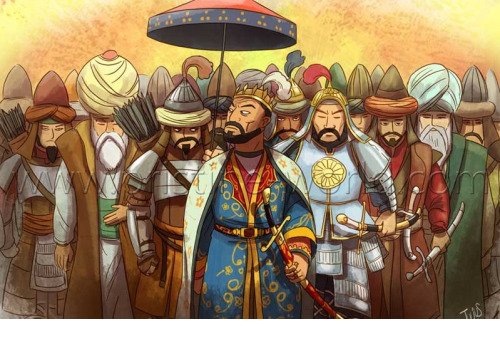The Barlas belonged to the Hamag Mongols, a northeastern confederation of nomadic tribes that would eventually unite their people into a single entity and become the core of the Mongol ethnic group. They shared a common origin with the Borjigin clan, to which Genghis Khan belonged, but separated from them a couple of centuries before his birth.
Nevertheless, the two clans were closely related and maintained friendly relations. The Barlas were among the first to join Temujin at the very beginning of his political career. Their leaders, Sugu Sechen and Karachar, were present at the kurultai of 1206, when their kinsman was elected Great Khan. And Hubilai-noyon (not to be confused with Khan Hubilai, Genghis Khan’s grandson) was one of the “four dogs” — particularly close confidants who became famous commanders, along with Jebe, Subutai, and Jelme.
Kublai Khan received an order from his lord to conquer the Karluks. These were Turkic tribes that had settled in the sedentary part of Central Asia. That is why the Barlas were involved in local affairs, and when the empire was divided into uluses, they came under the leadership of Chagatai.
Along with the Arulats, Jalayirs, and Suldus, our heroes today became one of the four tumens transferred to this Mongol prince by his father. Thus, they became the backbone of the Chagatai Khanate’s army, and the main part of the clan settled in the vicinity of the ancient city of Kesh. Today it is called Shakhrisabz and is located in the Kashkadarya region of Uzbekistan. It is less than 100 kilometers from Samarkand, one of the historical centers of the entire region.

It was a highly urbanized region inhabited by Tajiks and sedentary Turks. It was difficult to nomadize here, but the steppe dwellers took the place of its military class. As a result, they converted to Islam relatively quickly and adopted many of the customs of their subjects.
Their native language was almost forgotten, and the Mongols switched to the Chagatai dialect. This was one of the dialects of the Karluk group, an early version of the modern Uzbek language. In terms of everyday customs, the Chagatai were Muslims. But in the areas of state administration and army organization, they were guided by the Great Yasa.
In contrast, the inhabitants of the eastern part of the Chagatai ulus were not accustomed to city life and remained nomads. They preserved both their language and their old faith—even the area where they lived was named Mogulistan. The cultural divide between east and west led to many disasters, and in the 1330s, the khanate was the first of the Mongol states to split into two parts.
Tarmashirin Khan converted to Islam and based his policies on the settled population. In 1334, this led to his assassination by nomads who stood for the old customs and did not want to lose power. As a result, the Chingizids continued to rule in the east, while the west was controlled by Turkicized Mongol emirs who used the descendants of Genghis Khan as their puppets.

When Tamerlane was born in 1336, most of his tribe professed Islam and spoke Turkic. He belonged to the Barlas clan aristocracy, to their ruling line. His paternal uncle was Haji Barlas, the bek (leader) of the entire clan, who ruled Kesh and the city of Karshi.
Nevertheless, Timur became a prominent political figure in Maverannahr, apparently without the involvement of his relatives. But as he rose to power, the Barlas formed the core of this commander’s army. With the support of his own tribe, he established himself in Central Asia, repelled the campaigns of hostile khans of Moghulistan, and later enlisted them for his distant campaigns.
Even Ak-Saray, the residence of the “iron lame,” was located not in the capital Samarkand, but in his native city of Kesh. Under him, the Barlas reached the peak of their power. With the patronage of the ruler of the state, they began to move to other places. For example, their descendants now live even in Pakistan, where they are called Chukhtay (i.e., Chagatai).

Many tribes considered it an honor to be related to them. As a result, during the 15th century, this clan grew significantly, mainly due to the inclusion of Turks in its ranks. But at the beginning of the 16th century, power changed in Central Asia: the Timurids were expelled by immigrants from the Golden Horde. As a result, Tamerlane’s native tribe lost its dominant position. But it did not disappear; instead, it became the basis of the modern Uzbeks living in the Kashkadarya Vilayat of Uzbekistan.
